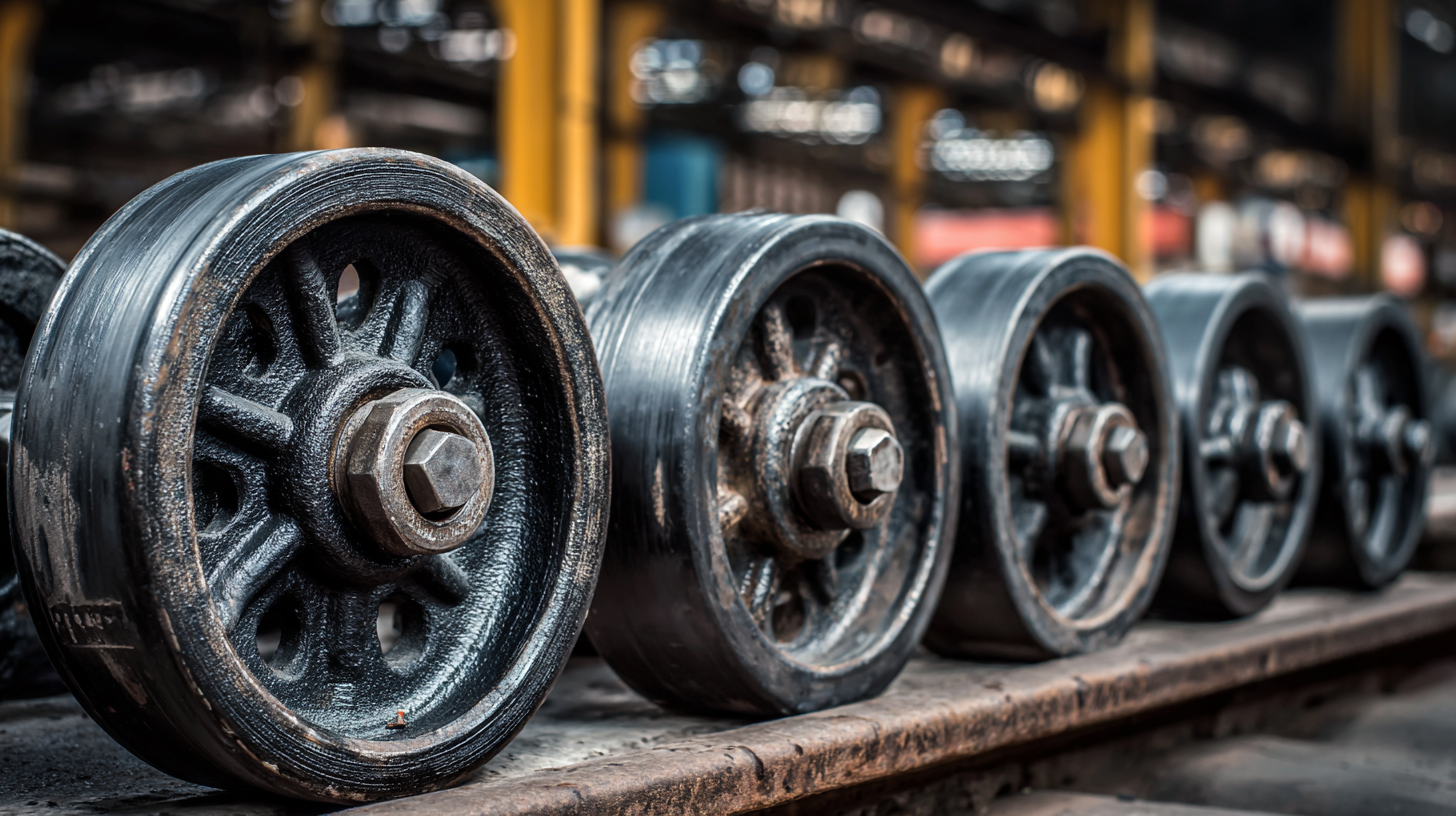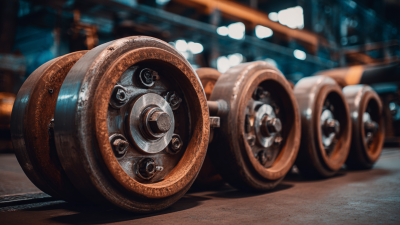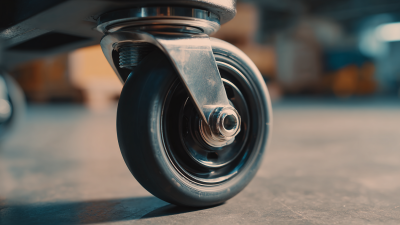
Exploring the Impact of Heavy Caster Wheels on Industrial Efficiency: Trends and Innovations
The evolution of industrial efficiency hinges on the adoption of advanced equipment and technology, with Heavy Caster Wheels emerging as a pivotal component in this transformation. According to recent industry reports, the market for caster wheels is projected to grow significantly, driven by innovations in materials and design aimed at enhancing load-bearing capacity and maneuverability. Heavy Caster Wheels, specifically engineered to support substantial weights while providing smooth mobility, are reshaping operational workflows across factories and warehouses. A study by the Material Handling Institute indicates that efficient material handling solutions reduce operational costs by up to 25%, demonstrating the critical role that Heavy Caster Wheels play in optimizing logistics and productivity. Furthermore, advancements such as shock absorption technology and ergonomic designs not only improve safety but also increase the lifespan of equipment, making these innovations essential for industries striving to achieve maximum efficiency in their operations.

The Role of Heavy Caster Wheels in Enhancing Load Management and Transport Efficiency
Heavy caster wheels play a pivotal role in enhancing load management and transport efficiency across various industrial settings. These wheels are designed to support substantial weight while providing smooth mobility, making them essential for heavy-duty applications. The utilization of heavy caster wheels not only simplifies the movement of heavy machinery and equipment but also reduces the risk of workplace injuries associated with manual handling. Their robust construction and innovative designs have led to better adaptability in diverse operating environments, enhancing overall productivity.

Tips: When selecting heavy caster wheels, consider the load capacity required for your specific needs. It's essential to match the wheel material—such as rubber or polyurethane—with the surface type to ensure optimal performance. Regular maintenance and inspection of caster wheels can also prolong their lifespan, contributing to sustained efficiency in transport.
Moreover, the innovative design of modern heavy caster wheels, including features like swivel capabilities and noise reduction technology, markedly improves operational workflows. These advancements help reduce the time and effort needed to move heavy items, allowing workers to focus on more value-added tasks, thereby driving overall efficiency in industrial processes. Properly integrating heavy caster wheels into your operational strategy can yield significant improvements in both safety and productivity.
Tips: Implementing a training program on the correct use of caster wheels can further enhance efficiency and safety. Encourage employees to report any issues with wheels immediately to prevent accidents and ensure continuous optimal performance.
Innovative Materials and Designs in Caster Wheel Technology for Industrial Applications
At the recent AICE 2025 SMM Aluminum Industry Conference, industry experts discussed the latest trends and innovations in caster wheel technology, particularly focusing on innovative materials and designs that enhance industrial efficiency. The shift towards high-performance caster wheels made from advanced composites and lightweight metals is revolutionizing the logistics landscape. Reports indicate that utilizing lightweight wheels can reduce operational energy consumption by approximately 15%, which translates into significant cost savings for companies. Enhanced designs that incorporate shock-absorbing features also promote a smoother operating environment, thereby increasing safety and productivity on the factory floor.
Tips: When selecting caster wheels for industrial applications, consider the weight capacity and floor type to maximize performance. Additionally, look for wheels with ergonomic features that can reduce strain on workers. A well-chosen caster wheel can not only improve efficiency but also extend the lifespan of your equipment.
With continuous advancements in wheel technology, innovations such as anti-static materials and noise-reducing designs are gaining importance. These innovations are particularly beneficial in sensitive environments like clean rooms or quiet operation zones, where minimizing disturbances is crucial. Industry studies suggest that noise reduction features in caster wheels can decrease ambient noise levels by up to 10 dB, enhancing worker comfort and concentration.
Assessing the Impact of Wheel Size and Load Capacity on Workflow Optimization
The efficiency of industrial operations is significantly influenced by the choice of caster wheels, particularly regarding their size and load capacity. Larger wheels tend to distribute weight more evenly, reducing the pressure on surfaces and allowing for smoother movement. This is essential in environments where machinery and equipment need to transport heavy loads over extended distances. The ability of large caster wheels to navigate obstacles easily further enhances workflow optimization, minimizing downtime and labor costs associated with manually handling cumbersome loads.
Additionally, the load capacity of caster wheels is a critical factor in maintaining productivity. Wheels designed with higher load capacities reduce the likelihood of breakage or malfunction under heavy conditions, thus ensuring continuous operation. This reliability not only boosts worker confidence in equipment but also streamlines processes, contributing to a more efficient workflow. As industries evolve, innovations in materials and engineering are leading to the development of casters that not only meet but exceed traditional load capacity requirements, illustrating a trend toward maximizing operational performance through advanced wheel design.
Exploring the Impact of Heavy Caster Wheels on Industrial Efficiency: Trends and Innovations
| Wheel Size (inches) | Load Capacity (lbs) | Material | Wheel Type | Efficiency Improvement (%) | Typical Application |
|---|---|---|---|---|---|
| 4 | 800 | Polyurethane | Standard | 15 | Warehouse Racks |
| 6 | 1200 | Rubber | Heavy-Duty | 20 | Manufacturing Equipment |
| 8 | 2000 | Nylon | Industrial | 25 | Pallet Jacks |
| 10 | 3000 | Polypropylene | Swivel | 30 | Heavy Machinery |
| 12 | 5000 | Metal | Fixed | 35 | Construction Equipment |
Trends in Automation and Smart Technology Integration with Caster Wheel Systems
 The integration of smart technology and automation within caster wheel systems is revolutionizing industrial efficiency. According to a recent report by the Material Handling Industry of America (MHIA), the incorporation of automation technologies can lead to a 20-30% increase in operational efficiency by streamlining transportation processes. As businesses strive to enhance their productivity, heavy caster wheels equipped with sensors and IoT connectivity are emerging as key players, providing real-time data on load weights, movement patterns, and maintenance needs.
The integration of smart technology and automation within caster wheel systems is revolutionizing industrial efficiency. According to a recent report by the Material Handling Industry of America (MHIA), the incorporation of automation technologies can lead to a 20-30% increase in operational efficiency by streamlining transportation processes. As businesses strive to enhance their productivity, heavy caster wheels equipped with sensors and IoT connectivity are emerging as key players, providing real-time data on load weights, movement patterns, and maintenance needs.
One notable trend is the rising use of intelligent caster wheels that can adapt to different loads and surfaces. This adaptability not only prolongs the lifespan of the wheels but also minimizes the risk of workplace accidents related to material handling. A report by the International Journal of Industrial Ergonomics indicates that implementing advanced caster systems can reduce injury rates by up to 40%. This innovation signifies a leap towards safer and more efficient industrial environments.
Tips: When considering an upgrade to caster wheel systems, assess your facility's unique needs and choose wheels that feature built-in automation capabilities. Additionally, investing in training for your staff on these new technologies can further enhance the overall efficiency of operations. Regular maintenance checks are crucial; integrating predictive maintenance can save costs and prevent downtime.
Best Practices for Maintenance and Care to Maximize Heavy Caster Wheel Lifespan
To maximize the lifespan of heavy caster wheels, regular maintenance and care are essential. One of the best practices involves routinely inspecting the wheels for any signs of wear or damage. Dust, debris, and other contaminants can accumulate over time, leading to increased friction and wear. Cleaning the wheels with appropriate solvents and lubricants can significantly enhance their performance and longevity. Operators should also check for proper wheel alignment and ensure that any obstructions in the path are removed to facilitate smoother movement.
Another critical aspect is the use of the right wheel for the specific application. Heavy caster wheels come in various materials and designs, and selecting the correct type based on the load capacity and surface conditions can prevent premature damage. For instance, polyurethane wheels are often favored for their durability and surface protection. Additionally, ensuring that the load is evenly distributed across the casters can mitigate undue stress. Implementing these practices not only prolongs the life of heavy caster wheels but also contributes to improved efficiency in industrial operations.
Impact of Heavy Caster Wheels on Industrial Efficiency
Related Posts
-

The Science Behind Heavy Caster Wheels and Their Impact on Workload Efficiency
-

What Are the Key Features of Caster Trolley Wheels
-

Exploring the Versatility of Swivel Plate Casters: Ultimate Guide to Choosing the Right Caster for Your Needs
-

How to Choose the Right Caster Trolley Wheels for Your Needs
-

Understanding the Challenges of Heavy Caster Wheels in Industrial Applications
-

How to Find the Best Caster Swivel Wheel Manufacturer for Your Business Needs
